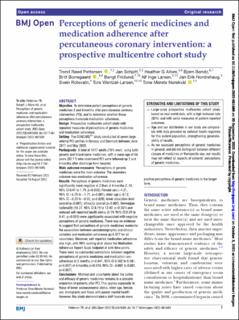| dc.description.abstract | Objective: To determine patient perceptions of generic medicines 2 and 6 months after percutaneous coronary intervention (PCI), and to determine whether these perceptions moderate medication adherence.
Design: Prospective multicentre cohort study with repeated measures of perceptions of generic medicines and medication adherence.
Setting: The CONCARDPCI study conducted at seven large referral PCI centres in Norway and Denmark between June 2017 and May 2020.
Participants: A total of 3417 adults (78% men), using both generic and brand name medicines, with a mean age of 66 years (SD 11) who underwent PCI were followed up 2 and 6 months after discharge from hospital.
Main outcome measures: Perceptions of generic medicines were the main outcome. The secondary outcome was medication adherence.
Results: Perceptions of generic medicines were significantly more negative at 2 than at 6 months (1.10, 95% CI 0.41 to 1.79, p=0.002). Female sex (−4.21, 95% CI −6.75 to −1.71, p=0.001), older age (−0.12, 95% CI −0.23 to −0.02, p=0.020), lower education level (overall p<0.001), ethnicity (overall p=0.002), Norwegian nationality (10.27, 95% CI 8.19 to 12.40, p<0.001) and reduced self-reported health status (0.19, 95% CI 0.09 to 0.41, p=0.003) were significantly associated with negative perceptions of generic medicines. There was no evidence to suggest that perceptions of generic medicines moderate the association between sociodemographic and clinical variables and medication adherence (p≥0.077 for all covariates). Moreover, self-reported medication adherence was high, with 99% scoring at or above the Medication Adherence Report Scale midpoint at both time points. There were no substantial correlations between negative perceptions of generic medicines and medication non-adherence at 2 months (r=0.041, 95% CI 0.002 to 0.081, p=0.037) or 6 months (r=0.038, 95% CI −0.005 to 0.081, p=0.057).
Conclusions: Mistrust and uncertainty about the safety and efficacy of generic medicines remains in a sizeable proportion of patients after PCI. This applies especially to those of lower socioeconomic status, older age, female sex, immigrants and those with poorer mental health. However, this study demonstrated a shift towards more positive perceptions of generic medicines in the longer term. | en_US |

